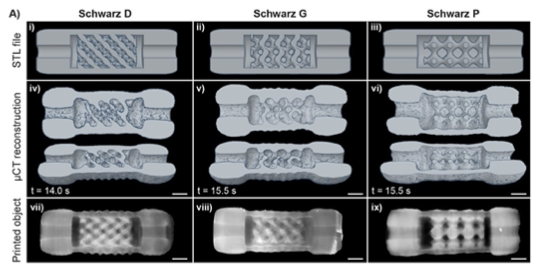Volumetric 3D printing is an exciting technology that could lead to extremely rapid production of 3D printed parts by curing every particle of the object at once. Now, researchers from Utrecht University are applying the process to bioprinting and have 3D printed functioning liver units at centimeter scale in less than 20 seconds. The results were published in Advanced Materials.
To accomplish this feat, the team relied on volumetric bioprinting (VBP) with a Tomolite system from Readily3D, a spin-out of Switzerland’s Ecole polytechnique fédérale de Lausanne. The system casts UV light from a 405 nm laser beam onto a rotating vat of cell-laden photopolymer, curing the material. Key to the technology was the ability to make cells transparent so that the light could cure the vat without light scattering from the medium.
The process was able to produce centimeter-scale 3D structures in under 20 seconds. While the printing itself took less than a minute, the printed cell-laden structures were cultured in liver differentiation media for 10 days. The cells used were organoids, which are tiny 3D structures able to express important organ-like behavior. However, organoids are difficult to utilize because it can be difficult to structure them without damaging them in the process. Due to the layerless and contactless approach of VBP, the organoids are handled more gently than an extrusion-based technique. In turn, organoid viability, shape, and function is maintained post-printing.

From the journal article: “Figure 1: Overview of the high-resolution volumetric printing process and study design. A) Schematic representation of the volumetric printing process. B-C) Highest resolution prints of B) positive and C) fully perfusable negative features achieved with the 5% gelMA+ 0.1% LAP bioresin used in this study (scale bars = 1 mm).Samples were imaged when being immersed in PBS directly after printing.D) Diagram of the hepatic organoid culture system, starting with human liver biopsies and isolation into single cells, which are then dynamically cultured in a spinner flask system to establish high yields of hollow epithelial organoid structures (microscopy image scale bar = 250 μm). E) Illustration of a complex, organoid-laden printed biofactory cultured under dynamic perfusion to enhance hepatic function, showing a representation of the breakdown of perfused compounds (purple circles) into metabolites (black squares). Figure 2: Effect of single cell and organoid density on volumetric bioprinting accuracyin absence of optical corrections. Fine feature thickness in constructs printed at increasing light doses (250 –625 mJ cm-2) with bioresins containingdifferentdensities ofA) single cell and B) organoid (1 –5 x 106cells mL-1). Dashed line represents the programmed feature dimensionof the printed model(selected to be 500 μmto accommodate for the size of the printed organoids)(n = 3).” Image courtesy of Advanced Materials.
The bioprinted organoids were able to demonstrate key liver functions that included the production of albumin, which prevents fluid from leaking out of blood vessels and into tissues, as well as liver-specific enzyme activity, and polarization. This last characteristic is important as it means that the 3D printed structures were capable of “directional transfer and secretion of compounds from and towards the apical or basolateral side of the cell.” Moreover, the research team experimented with different lattice shapes with varying degrees of curving, determining that the detoxification of ammonia could be improved depending on the geometry of the structure.

From the article, “Complex, perfusable architectures were successfully printed within seconds with an adjusted lattice design that enables coupling to microfluidic tubing as shown in the i-iii) STL models of the i) Schwarz D, ii) Schwarz G and iii) Schwarz P architectures.” Image courtesy of Advanced Materials.
Study author Riccardo Levato, Associate Professor from Utrecht University, told 3D Printing Media Network (3DMN), “Via bioprinting, we also create different porous structures that can be perfused with nutrients, and “replace” the role of blood vessels,” Levato also told 3dpbm. “These bioprinted liver units of such clinically relevant sizes open new opportunities for regenerative medicine and for developing new patient-specific models to study new drugs against liver diseases.”
This isn’t the first tissue that Readily3D’s printers have been used to make. Previously, the company’s technology was utilized to 3D print pancreases (seen above). The company is still in its nascent stages, but bioprinting as a whole is taking off. Because bioprinted organs for transplant will likely take some time, the more timely question here might not be when will Readily3D’s technology is used to make complete organs, but when will the firm get acquired by BICO or 3D Systems.
Subscribe to Our Email Newsletter
Stay up-to-date on all the latest news from the 3D printing industry and receive information and offers from third party vendors.
You May Also Like
Profiling a Construction 3D Printing Pioneer: US Army Corps of Engineers’ Megan Kreiger
The world of construction 3D printing is still so new that the true experts can probably be counted on two hands. Among them is Megan Kreiger, Portfolio Manager of Additive...
US Army Corps of Engineers Taps Lincoln Electric & Eaton for Largest 3D Printed US Civil Works Part
The Soo Locks sit on the US-Canadian border, enabling maritime travel between Lake Superior and Lake Huron, from which ships can reach the rest of the Great Lakes. Crafts carrying...
Construction 3D Printing CEO Reflects on Being Female in Construction
Natalie Wadley, CEO of ChangeMaker3D, could hear the words of her daughter sitting next to her resounding in her head. “Mum, MUM, you’ve won!” Wadley had just won the prestigious...
1Print to Commercialize 3D Printed Coastal Resilience Solutions
1Print, a company that specializes in deploying additive construction (AC) for infrastructure projects, has entered an agreement with the University of Miami (UM) to accelerate commercialization of the SEAHIVE shoreline...





























